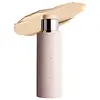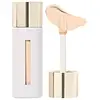Westman Atelier Vital Skin Foundation Stick Versus Westman Atelier Vital Skincare Brightening Concealer With Hyaluronic Acid
What's inside
What's inside
 Key Ingredients
Key Ingredients

 Benefits
Benefits

 Concerns
Concerns

 Ingredients Side-by-side
Ingredients Side-by-side

Caprylic/Capric Triglyceride
MaskingIsononyl Isononanoate
EmollientIsodecyl Neopentanoate
EmollientDicalcium Phosphate
AbrasiveMicrocrystalline Wax
Emulsion StabilisingSqualane
EmollientPolyethylene
AbrasiveVp/Hexadecene Copolymer
Synthetic Wax
AbrasiveDisteardimonium Hectorite
StabilisingHydrogenated Polyisobutene
EmollientSilica
AbrasiveNylon-12
Camellia Oleifera Seed Oil
Skin ConditioningHydrogenated Coconut Oil
EmollientPhytosphingosine
Skin ConditioningButyl Stearate
EmollientIsostearyl Alcohol
EmollientAlcohol
AntimicrobialWater
Skin ConditioningPentaerythrityl Tetra-Di-T-Butyl Hydroxyhydrocinnamate
AntioxidantButylene/Ethylene/Styrene Copolymer
Ethylene/Propylene/Styrene Copolymer
Mica
Cosmetic ColorantDibutyl Lauroyl Glutamide
Skin ConditioningRubus Idaeus Leaf Cell Culture
Skin ConditioningTin Oxide
AbrasiveCaprylic/Capric Triglyceride, Isononyl Isononanoate, Isodecyl Neopentanoate, Dicalcium Phosphate, Microcrystalline Wax, Squalane, Polyethylene, Vp/Hexadecene Copolymer, Synthetic Wax, Disteardimonium Hectorite, Hydrogenated Polyisobutene, Silica, Nylon-12, Camellia Oleifera Seed Oil, Hydrogenated Coconut Oil, Phytosphingosine, Butyl Stearate, Isostearyl Alcohol, Alcohol, Water, Pentaerythrityl Tetra-Di-T-Butyl Hydroxyhydrocinnamate, Butylene/Ethylene/Styrene Copolymer, Ethylene/Propylene/Styrene Copolymer, Mica, Dibutyl Lauroyl Glutamide, Rubus Idaeus Leaf Cell Culture, Tin Oxide
Water
Skin ConditioningC9-12 Alkane
SolventOctyldodecyl Neopentanoate
EmollientGlycerin
HumectantDiisostearoyl Polyglyceryl-3 Dimer Dilinoleate
EmollientSodium Potassium Aluminum Silicate
Disteardimonium Hectorite
StabilisingCaprylic/Capric Triglyceride
MaskingTribehenin
EmollientHelianthus Annuus Seed Oil
EmollientGlycyrrhiza Glabra Root Extract
BleachingGentiana Lutea Root Extract
Skin ConditioningCoffea Arabica Seed Extract
MaskingPalmitoyl Pentapeptide-4
Skin ConditioningHydrolyzed Sodium Hyaluronate
Skin ConditioningCoco-Caprylate/Caprate
EmollientDisodium Stearoyl Glutamate
CleansingSodium Chloride
MaskingCaprylyl Glycol
EmollientPropylene Carbonate
SolventPotassium Sorbate
PreservativeSilica
AbrasivePropanediol
SolventAluminum Hydroxide
EmollientCitric Acid
BufferingCI 77891
Cosmetic ColorantWater, C9-12 Alkane, Octyldodecyl Neopentanoate, Glycerin, Diisostearoyl Polyglyceryl-3 Dimer Dilinoleate, Sodium Potassium Aluminum Silicate, Disteardimonium Hectorite, Caprylic/Capric Triglyceride, Tribehenin, Helianthus Annuus Seed Oil, Glycyrrhiza Glabra Root Extract, Gentiana Lutea Root Extract, Coffea Arabica Seed Extract, Palmitoyl Pentapeptide-4, Hydrolyzed Sodium Hyaluronate, Coco-Caprylate/Caprate, Disodium Stearoyl Glutamate, Sodium Chloride, Caprylyl Glycol, Propylene Carbonate, Potassium Sorbate, Silica, Propanediol, Aluminum Hydroxide, Citric Acid, CI 77891
 Reviews
Reviews

Ingredients Explained
These ingredients are found in both products.
Ingredients higher up in an ingredient list are typically present in a larger amount.
This ingredient is an emollient, solvent, and texture enhancer. It is considered a skin-softener by helping the skin prevent moisture loss.
It helps thicken a product's formula and makes it easier to spread by dissolving clumping compounds.
Caprylic Triglyceride is made by combining glycerin with coconut oil, forming a clear liquid.
While there is an assumption Caprylic Triglyceride can clog pores due to it being derived from coconut oil, there is no research supporting this.
Learn more about Caprylic/Capric TriglycerideDisteardimonium Hectorite comes from the clay mineral named hectorite. It is used to add thickness to a product.
It can also help stabilize a product by helping to disperse other ingredients.
Hectorite is a rare, white clay mineral.
Learn more about Disteardimonium HectoriteSilica, also known as silicon dioxide, is a naturally occurring mineral. It is used as a fine, spherical, and porous powder in cosmetics.
Though it has exfoliant properties, the function of silica varies depending on the product.
The unique structure of silica enhances the spreadability and adds smoothness, making it a great texture enhancer.
It is also used as an active carrier, emulsifier, and mattifier due to its ability to absorb excess oil.
In some products, tiny microneedles called spicules are made from silica or hydrolyzed sponge. When you rub them in, they lightly polish away dead skin layers and enhance the penetration of active ingredients.
Learn more about SilicaWater. It's the most common cosmetic ingredient of all. You'll usually see it at the top of ingredient lists, meaning that it makes up the largest part of the product.
So why is it so popular? Water most often acts as a solvent - this means that it helps dissolve other ingredients into the formulation.
You'll also recognize water as that liquid we all need to stay alive. If you see this, drink a glass of water. Stay hydrated!
Learn more about Water